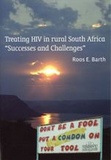Treating HIV in rural South Africa
“Successes and Challenges”

Barth, Roos
- Promoter:
- Prof.dr. A.I.M. (Andy) Hoepelman & prof.dr H.A. (Hugo) Tempelman
- Co-promoter:
- Dr A.J.M. (Anne) Wensing & dr J.T.M. (Jan) van der Meer
- Research group:
- Wensing Nijhuis , Hoepelman
- Date:
- May 27, 2010
- Time:
- 12:45 h
Summary
This thesis presents the first testimony of a unique collaboration between Ndlovu Medical Centre (NMC) in Elandsdoorn, South Africa, and the University Medical Centre in Utrecht (UMCU), The Netherlands. Sub-Saharan Africa continues to be the region most affected by HIV, and South Africa is the country with the highest number of HIV-infected individuals. Fortunately, global access to antiretroviral treatment (ART) has improved considerably. Over the last decade, many ART programmes took off, treating millions of HIV-infected patients. However, monitoring and research facilities in LICs still lag behind. NMC is one of the clinics providing HIV-care in South Africa. The clinic is unique due to the provision of extensive counselling and laboratory monitoring to all patients. The aim of this thesis was to evaluate the virological efficacy of NMC’s ART programme. Moreover, some general HIV-care related issues, such as co-infections, are addressed. The first part of this thesis reviews available virological data of Sub-Saharan African ART programmes. In the following chapters (part two) we analyse the outcome data of NMC’s HIV-treatment programme. On treatment results were excellent; patients gained weight, had a significant increase in their CD4+ T-cell counts and most reached virological suppression. Achieving such results is an impressive accomplishment, but early mortality was high, negatively influencing intention-to-treat results. Virological failure was observed during follow-up in 15% of adults and 40% of children. In case of a sub-optimal virological response, the virus can select drug-resistance mutations. Such mutations can limit future treatment options. We therefore sought to determine common drug-resistance profiles in patients experiencing treatment failure (part three). First-line ART in African treatment programmes generally consists of a non-nucleoside reverse transcriptase inhibitor (NNRTI), combined with two nucleoside reverse transcriptase inhibitors (NRTIs). As a result, resistance profiles typically showed the lamivudine-associated M184V mutation and multiple NNRTI-associated mutations at first detection of virological failure. These data suggest that many NRTIs (excluding lamivudine) may still be effective. However, we later show that an accumulation of NRTI-associated mutations can occur when first-line drugs are continued in spite of ongoing viral replication. This is worrisome; especially as such high-level resistance will frequently stay unnoticed due to the limited virological monitoring in most African clinics. In part four, we address some issues regarding important opportunistic infections. We reviewed the potential of a new diagnostic test for tuberculosis (interferon-gamma-release-assay, IGRA) in a setting where both HIV and TB are highly endemic. Unfortunately IGRAs seem to have limited value in such a setting due to their lack of discrimination between latent and active infections and for financial and logistic reasons. Subsequently, we determined hepatitis B (HBV) and C (HCV) prevalence-rates. Both hepatitis viruses are highly prevalent in Africa, but there are large regional differences. An exceptionally low prevalence of active HBV was observed at the NMC. Occult HBV infections on the other hand were observed in a substantial proportion of HIV-infected individuals. To conclude (part five), we describe successes achieved in global HIV-care, and the challenges that remain for the future.